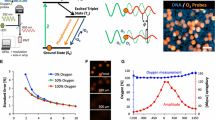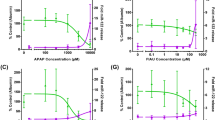Abstract
We have integrated in vitro and in silico information to investigate acetaminophen (APAP) and its metabolite N-acetyl-p-benzoquinone imine (NAPQI) toxicity in liver biochip. In previous works, we observed higher cytotoxicity of HepG2/C3a cultivated in biochips when exposed to 1 mM of APAP for 72 h as compared to Petri cultures. We complete our investigation with the present in silico approach to extend the mechanistic interpretation of the intracellular kinetics of the toxicity process. For that purpose, we propose a mathematical model based on the coupling of a drug pharmacokinetic model (PK) with a systemic biology model (SB) describing the reactive oxygen species (ROS) production by NAPQI and the subsequent glutathione (GSH) depletion. The SB model was parameterized using (i) transcriptomic data, (ii) qualitative results of time lapses ROS fluorescent curves for both control and 1-mM APAP-treated experiments, and (iii) additional GSH literature data. The PK model was parameterized (i) using the in vitro kinetic data (at 160 μM, 1 mM, 10 mM), (ii) using the parameters resulting from a physiologically based pharmacokinetic (PBPK) literature model for APAP, and (iii) by literature data describing NAPQI formation. The PK-SB model predicted a ROS increase and GSH depletion due to the NAPQI formation. The transition from a detoxification phase and NAPQI and ROS accumulation was predicted for a NAPQI concentration ranging between 0.025 and 0.25 μM in the cytosol. In parallel, we performed a dose response analysis in biochips that shows a reduction of the final hepatic cell number appeared in agreement with the time and doses associated with the switch of the NAPQI detoxification/accumulation. As a result, we were able to correlate in vitro extracellular APAP exposures with an intracellular in silico ROS accumulation using an integration of a coupled mathematical and experimental liver on chip approach.







Similar content being viewed by others
Abbreviations
- Ahr:
-
Aryl hydrocarbon receptor
- APAP:
-
Acetaminophen
- CYP:
-
Cytochrome P450 gene
- DCFDA:
-
2′,7′-Dichlorofluorescin diacetate
- GCLC:
-
Glutamate-cysteine ligase catalityc subunit gene
- GCLM:
-
Glutamate-cysteine ligase regulatory subunit gene
- GPX:
-
Glutathione peroxidase gene
- GSH:
-
Glutathione
- GS:
-
Glutathione synthetase gene
- GST:
-
Glutathione S transferase gene
- Keap-1:
-
Kelch-like ECH-associated protein 1
- MRP:
-
Multidrug resistance-associated protein gene
- NAPQI:
-
N-Acetyl-p-benzoquinone imine
- NFE2L2:
-
Nuclear factor (erythroid-derived 2)-like 2 gene
- Nrf2:
-
Protein code by NFE2L2 gene
- PBPK:
-
Physiologically based pharmacokinetic
- PK:
-
Pharmacokinetic
- ROS:
-
Reactive oxygen species
- SB:
-
Systems biology
References
Baudoin R, Alberto G, Legendre A, Paullier P, Naudot M, Fleury MJ, et al. Investigation of the levels of expression and activity of detoxication genes of primary rat hepatocytes under various flow rates and cell densities in microfluidic biochips. Biotechnol Prog. 2014a;30:401–10.
Baudoin R, Legendre A, Jacques S, Cotton J, Bois F, Leclerc E. Evaluation of a liver microfluidic biochip to predict In vivo clearances of seven drugs in rats. J Pharm Sci. 2014b;103:706–18.
Ben-Shachar R, Chen Y, Luo S, Hartman C, Reed M, Nijhout F. The biochemistry of acetaminophen hepatotoxicity and rescue: a mathematical model. Theor Biol Med Model. 2012;9:55–65.
Bois FY. GNU MCSIM: Bayesian statistical inference for SBML coded systems biology models. Bioinformatics. 2009;25:1453–4.
Bois FY. Baysian inference. Methods Mol Biol. 2013;930:597–636.
Bricks T, Paullier P, Legendre A, Cotton J, Fleury MJ, Zeller P, et al. Development of a new microfluidic platform integrating co cultures of intestinal and liver cell lines. Toxicol in Vitro. 2014;28:885–95.
Choucha Snouber L, Jacques S, Monge M, Legallais C, Leclerc E. Transcriptomic analysis of the effect of the ifosfamide on MDCK cells cultivated in microfluidic biochips. Genomics. 2012a;100:27–34.
Choucha Snouber L, Letourneur F, Chafey P, Broussard C, Monge M, Legallais C, et al. Analysis of transcriptomic and proteomic profiles demonstrates the improvement of the MDCK cell function in a renal microfluidic biochip. Biotechnol Prog. 2012b;28:474–84.
Choucha Snouber L, Aninat C, Grsicom L, Madalinski G, Brochot C, Poleni PE, et al. Investigation of ifosfamide nephrotoxicity induced in a liver kidney co-culture biochip. Biotechnol Bioeng. 2013;110:597–608.
Coles B, Wilson I, Wardaman P, Hinson J, Nelson S, Ketterer B. The spontaneous and enzymatic reaction of N-acetyl-pbenzoquinonimine with glutathione: a stopped-flow kinetic study. Arch Biochem Biophys. 1998;264:253–60.
Esch M, King T, Shuler M. The role of body-on-a-chip devices in drug and toxicity studies. Annu Rev Biomed Eng. 2011;13:55–72.
Geenen S, Yates J, Kenna G, Bois F, Wilson I, Westerhoff H. Multiscale modelling approach combining a kinetic model of glutathione metabolism with PBPK models of acetaminophen and the potential glutathionedepletion biomarkers ophthalmic acid and 5-oxoproline in humans and rats. Integr Biol. 2013;5:877–83.
Gelman A, Rubin DB. Inference from iterative simulation using multiple sequences (with discussion). Stat Sci. 1992;7:457–511.
Ghauri FY, McLean AE, Beales D, Wilson ID, Nicholson JK. Induction of 5-oxoprolinuria in the rat following chronic feeding with N-acetyl 4-aminophenol (acetaminophen). Biochem Pharmacol. 1993;46:953–7.
Gregoire N, Hovsepian L, Gualano V, Evene E, Dufour G, Gendron A. Safety and pharmacokinetics of acetaminophen following intravenous administration of 5 g during the first 24 h with a 2-g starting dose. Clin Pharmacol Ther. 2007;81:401–5.
Hamon J, Jennings P, Bois F. Systems biology modeling of omics data: effect of cyclosporine a on the Nrf2 pathway in human renal cells. BMC Syst Biol. 2014;8:1752–8.
Huh D, Matthews B, Mammamoto A, Montoyo Zavala M, Hsin H, Ingber D. Reconstruction organ level lung function on a chip. Science. 2010;25:1662–8.
Leclerc E, Hamon J, Legendre A, Bois F. Integration of pharmacokinetic and NRF2 system biology models to describe reactive oxygen species production and subsequent glutathione depletion in liver microfluidic biochips after flutamide exposure. Toxicol in Vitro. 2014;28:1230–41.
Legendre A, Baudoin R, Alberto G, Paullier P, Naudot M, Bricks T, et al. Metabolic characterization of primary rat hepatocytes cultivated in parallel microfluidic biochips. J Pharm Sci. 2013;102:3264–76.
Legendre A, Jacques S, Dumont F, Cotton J, Paullier P, Fleury MJ, et al. Investigation of the hepatotoxicity of flutamide: pro-survival/apoptotic and necrotic switch in primary rat hepatocytes characterized by metabolic and transcriptomic profiles in microfluidic liver biochips. Toxicol in Vitro. 2014;28:1075–87.
Lord R, Bralley A. Clinical applications of urinary organic acids. Part 1: detoxification markers. Altern Med Rev. 2008;13:205–15.
Lu SC. Regulation of hepatic glutathione synthesis: current concepts and controversies. FASEB J. 1999;13:1169–83.
Mahler GJ, Esch MB, Glahn RP, Shuler ML. Characterization of a gastrointestinal tract microscale cell culture analog used to predict drug toxicity. Biotechnol Bioeng. 2009;104:193–205.
Mari M, Cederbaum A. CYP2E1 overexpression in HepG2 cells induces glutathione synthesis by transcriptional activation of g-glutamylcysteine synthetase. J Biol Chem. 2000;275:15563–71.
Midwoud PM, van Merema MT, Verpoorte E, Groothuis GMM. A microfluidic approach for in vitro assessment of interorgan interactions in drug metabolism using intestinal and liver slices. Lab Chip. 2010;10:2778–86.
Nagai H, Matsumaru K, Feng G, Kaplowitz N. Reduced glutathione depletion causes necrosis and sensitization to tumor necrosis factor alpha–induced apoptosis in cultured mouse hepatocytes. Hepatology. 2002;36:55–64.
Novik E, Maguire TJ, Chao P, Cheng KC, Yarmush ML. A microfluidic hepatic coculture platform for cell-based drug metabolism studies. Biochem Pharmacol. 2010;79:1036–44.
Patten C, Thomas P, Guy R, Lee M. Cytochrome P450 enzymes involved in acetaminophen activation by Rat and human liver microsomes and their kinetics. Chem Res Toxicol. 1993;6:511–8.
Prot JM, Aninat C, Griscom L, Razan F, Brochot C, Guguen Guillouzo C, et al. Improvement of HepG2/C3a cell functions in a microfluidic biochip. Biotechnol Bioeng. 2011;108:1704–15.
Prot JM, Bunescu A, Elena-Hermann B, Aninat C, Choucha Snouber L, Griscom L, et al. Predictive toxicology using systemic biology and liver microfluidic “on chip” approaches: application to acetaminophen injury. Toxicol Appl Pharmacol. 2012;259:270–80.
Reid AB, Kurten RC, McCullough SS, Brock RW, Hinson JA. Mechanisms of acetaminophen-induced hepatotoxicity: role of oxidative stress and mitochondrial permeability transition in freshly isolated mouse hepatocytes. J Pharmacol Exp Ther. 2005;312:509–16.
Sivaraman A, Leach JK, Townsend S, Iida T, Hogan BJ, Stolz DB, Fry R, Samson LD,Tannenbaum SR, Griffith LG. A microscale in vitro physiological model of the liver: predictive screens for drug metabolism and enzyme induction. Curr Drug Metab. 2005;6:569–92.
Sung JH, Kam C, Shuler MJ. A microfluidic device for a pharmacokinetic–pharmacodynamic (PK–PD) model on a chip. Lab Chip. 2010;10:446–55.
Sung J, Esch M, Prot JM, Long C, Smith A, Hickman J, et al. Microfabricated mammalian organ systems and their integration into models of whole animals and humans. Lab Chip. 2013;13:1201–10.
Toh YC, Lim TC, Tai D, Xiao G, van Noort D, Yu H. A microfluidic 3D hepatocyte chip for drug toxicity testing. Lab Chip. 2009;9:2026–31.
Tsuboi S. Elevation of glutathione level in Rat hepatocytes by hepatocyte growth factor via induction of 7-glutamylcysteine synthetase. J Biochem. 1999;126:815–20.
Viravaidya K, Shuler ML. Incorporation of 3 T3-L1 cells to mimic bioaccumulation in a microscale cell culture analog device for toxicity studies. Biotechnol Prog. 2004;20:590–7.
Wikswo J, Curtis E, Eagleton Z, Evans B, Kole A, Hofmeister L, et al. Scaling and systems biology for integrating multiple organs-on-a-chip. Lab Chip. 2013;13:3496–502.
Zanese M, Suter L, Roth A, De Giorgi F, Ichas F. High-throughput flow cytometry for predicting drug-induced hepatotoxicity. In: Schmid I, editor. Clinical Flow Cytometry – Emerging Applications. InTech, 2012. doi:10.5772/38270.
Zhang D. Mechanistic studies of the NRF2-KEAP1 signaling pathway. Drug Metab Rev. 2006;38:769–89.
Zhang Q, Pi J, Woods C, Andersen M. Phase I to II cross-induction of xenobiotic metabolizing enzymes: a feedforward control mechanism for potential hormetic responses. Toxicol Appl Pharmacol. 2009;237:345–56.
Acknowledgments
This work was carried out in the framework of the Labex MS2T, which was funded by the French Government, through the program “Investments for the future” managed by the National Agency for Research (ANR-11-IDEX-0004-02). The work was supported by the “fondation UTC pour la recherche” via the chaire in predictive toxicology and the project “Puces à cellules 3D”
Conflict of interest
We declare no conflict of interest.
Author information
Authors and Affiliations
Corresponding author
Rights and permissions
About this article
Cite this article
Leclerc, E., Hamon, J., Claude, I. et al. Investigation of acetaminophen toxicity in HepG2/C3a microscale cultures using a system biology model of glutathione depletion. Cell Biol Toxicol 31, 173–185 (2015). https://doi.org/10.1007/s10565-015-9302-0
Received:
Accepted:
Published:
Issue Date:
DOI: https://doi.org/10.1007/s10565-015-9302-0




